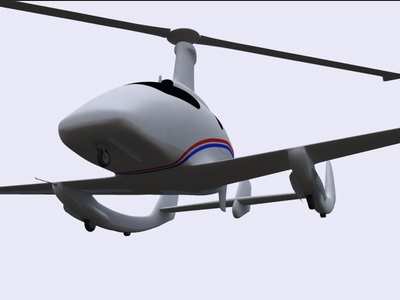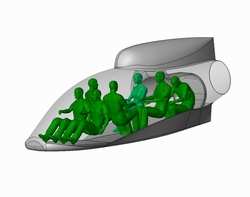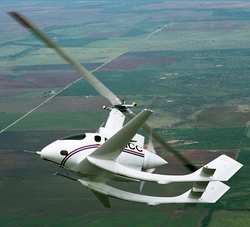New Name Leads Slew Of Announcements At Sun-N-Fun 2003
By ANN Correspondent Juan Jimenez
 What's in a name? In the case of CarterCopters
LLC, it was too much of a reference to the aircraft and not enough
to the business of the company. Hence, it was announced today at
Sun-N-Fun 2003 that the company now has a new name which more
closely reflects what the company actually does for a living:
Carter Aviation Technologies.
What's in a name? In the case of CarterCopters
LLC, it was too much of a reference to the aircraft and not enough
to the business of the company. Hence, it was announced today at
Sun-N-Fun 2003 that the company now has a new name which more
closely reflects what the company actually does for a living:
Carter Aviation Technologies.
According to company spokesperson Ms. Anita Infante, the new
name was chosen because it matches the company's emphasis on
research and development of technologies with the intention of
licensing them to aircraft manufacturers, rather than the direct
production of aircraft. The prototype aircraft that the company is
currently developing and flying will still be called CarterCopters,
said company founder Jay Carter Jr., "but our company is much more
than a unique aircraft. We are developing new, global impact
technologies for aviation as a result of creative engineering and
thinking outside the norm."

In a press conference that covered a wide range of subjects, the
company also made several other announcements. A new prototype of
the CarterCopter, which the company has christened the Next
Generation CarterCopter (NxCC), is now under construction. The
design incorporates a number of changes, including:
- The fuselage will be extended by over three feet to reduce drag
caused by airflow separation.
- The wingspan will be increased.
- The booms will be placed at a wider stance.
- An additional vertical stabilizer will be added.
- A new, high-Mu rotor and spinner will be installed.
- The new interior will feature an expanded cabin offering a
choice of seating for six or seven - one option will even include a
small lavatory!
- A 2,000 shp turboprop engine

The projected performance for this new prototype, if achieved,
should impress even the staunchest non-believers.
- 2,500 lbs empty weight
- 5,000 lbs gross weight while retaining VTOL capability
- 6,000 lbs gross weight with 200 ft rolling takeoff
- 350 mph top speed
- 30,000 ft cruise altitude in a pressurized cockpit
- 2,000 mile range with 1,000 lb useful load
 No completion schedule has been announced as of
yet for this iteration of the CarterCopter. However, one thing was
made clear, and that is that in tune with the company's emphasis on
R&D, the prototype will be shown in non-aviation venues as well
as in the traditional aviation industry trade shows and
fly-ins.
No completion schedule has been announced as of
yet for this iteration of the CarterCopter. However, one thing was
made clear, and that is that in tune with the company's emphasis on
R&D, the prototype will be shown in non-aviation venues as well
as in the traditional aviation industry trade shows and
fly-ins.
Mentioned as well during the conference was the importance of
the use of Laminar Research's X-Plane simulation software during
the development of the CarterCopter. Mr. Carter put it in simple
words - without Austin Meyer's product, it is very likely that the
company would not exist. Carter talked about one particular
instance during a flight test in which the CarterCopter suddenly
went nose-high and climbed nearly 2,000 feet for no apparent
reason. The aircraft lost nearly all airspeed during the excursion.
It turned out, however, that the test pilots had been using X-Plane
to "fly" the prototype through the same tests on the ground, and
had run into the exact problem while in the sim. Because they had
seen the behavior in the sim, they immediately recognized what was
going on and executed a smooth, uneventful recovery.
 Thanks to an agreement between CarterCopters and
Austin Meyer, the model developed by the company for the prototype
is included with X-Plane, and in the near future the model
developed for the new NxCC prototype will also be made available to
the public.
Thanks to an agreement between CarterCopters and
Austin Meyer, the model developed by the company for the prototype
is included with X-Plane, and in the near future the model
developed for the new NxCC prototype will also be made available to
the public.
One of the more interesting modifications incorporated into the
NxCC is a change to the rotor tips which is expected to allow the
company to come that much closer to break the Mu-1 barrier. This
barrier refers to the long-standing belief that the ratio of the
forward speed of the aircraft to the tip speed of the rotors can
never exceed a value of one without destroying the rotors. When a
helicopter is hovering, the value of Mu (represented by the Greek
symbol ) is zero. In the CarterCopter, as the forward speed
of the aircraft increases, lift is transferred from the rotors to
the wings. This allows the rotor RPM to be reduced, which obviously
reduces the rotor tip speed, in the same way that the tip speed of
a conventional aircraft propeller is reduced when RPM is
reduced.
 However, as RPM slows and speed increases, airflow
over the retreating blade of the rotor is reversed. Previous
research had shown that long before the ratio of Mu could reach a
value of one, the rotor would become unstable and flap
uncontrollably, leading to a catastrophic failure. The only two
rotorcraft to achieve Mu values approaching a value of one were the
Cheyenne (0.8) and the McDonnell XV-1 (0.95). Neither of these
rotorcraft went into production.
However, as RPM slows and speed increases, airflow
over the retreating blade of the rotor is reversed. Previous
research had shown that long before the ratio of Mu could reach a
value of one, the rotor would become unstable and flap
uncontrollably, leading to a catastrophic failure. The only two
rotorcraft to achieve Mu values approaching a value of one were the
Cheyenne (0.8) and the McDonnell XV-1 (0.95). Neither of these
rotorcraft went into production.
On March 22, 2002, the CarterCopter reached a forward speed of
173 mph and an Mu of 0.87. One of the results of this flight test
was the conclusion that the company engineers still needed to work
on stability of the rotor blade at high Mu values. Carter theorized
that the way to prevent the rotor system from destabilizing was to
overcompensate on the advancing rotor blade in order to negate the
instability of the retreating rotor blade. Because the CarterCopter
rotor incorporates a single spar, it is somewhat easier to control
this instability. One of the modifications that Carter is
incorporating into the rotor design is something that could not be
done without composites - the addition of 55 lbs of lead ballast to
the rotor tip. Carter estimates that this modification will allow
the blade to reach an Mu of 0.9 or higher, and still remain within
the 5 to 1 safety factor that he demands of all systems on the
aircraft.

All of this activity has not gone unnoticed by the military
establishment. Carter argues that the reason for the development of
tilt-rotor aircraft is the belief that the Mu=1 barrier could not
be broken. According to him, this has led to over $50 billion being
spent on tilt-rotor technology. Now that Carter is making progress
in proving the belief wrong, this is creating some doubt about
where future funding should be directed. Nothing would please the
military more than the development of an aircraft with features
such as what the CarterCopter is demonstrating or plans to show on
NxCC. For example, current production rotorcraft cannot nose up or
down in a hover and at the same time maintain a fixed position over
the ground, a ship, or some other object. The CarterCopter's
tilting rotor mast can be incorporated into a design that would
allow exactly such a maneuver to be accomplished.
Another interesting announcement at the conference was the
development of a new propeller system for an unnamed UAV. The
propeller developed for this aircraft is unique in that it has been
tested at tip speeds over Mach 1.0. The prop, which weighs all of
eight tenths of a pound, required a 100-hp powerplant to accomplish
this feat. Most of the power, however, was expended as noise during
testing.

Finally, Carter pointed out that in the middle of the
celebrations of the anniversary of the first flight of the Wright
Flyer, no one was paying much attention to the 80th anniversary of
the first flight of the Cierva C.4 in 1923. Juan de la Cierva's
aircraft, the first autogyro, flew in January of that year. Five
years later, in 1928, Harold Pitcairn made history when he flew the
first autogyro in the US under a license from de la Cierva. Working
together, they later developed the first articulating rotor head,
which Igor Sikorsky later licensed for use on the world's first
production helicopter.
 SpaceX to Launch Inversion RAY Reentry Vehicle in Fall
SpaceX to Launch Inversion RAY Reentry Vehicle in Fall Aero-News: Quote of the Day (04.23.24)
Aero-News: Quote of the Day (04.23.24) Aero-News: Quote of the Day (04.20.24)
Aero-News: Quote of the Day (04.20.24) ANN's Daily Aero-Linx (04.20.24)
ANN's Daily Aero-Linx (04.20.24) Aero-News: Quote of the Day (04.21.24)
Aero-News: Quote of the Day (04.21.24)










